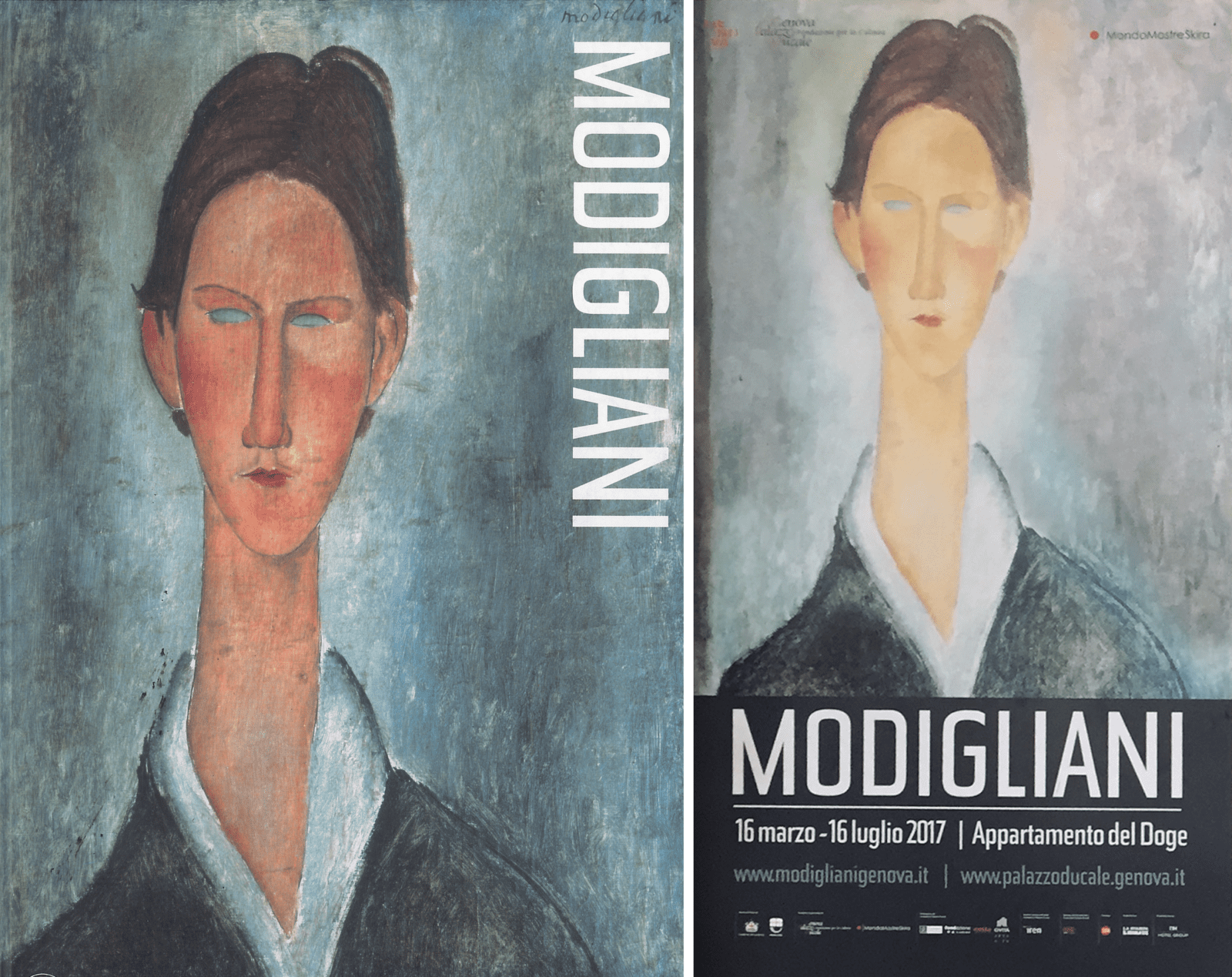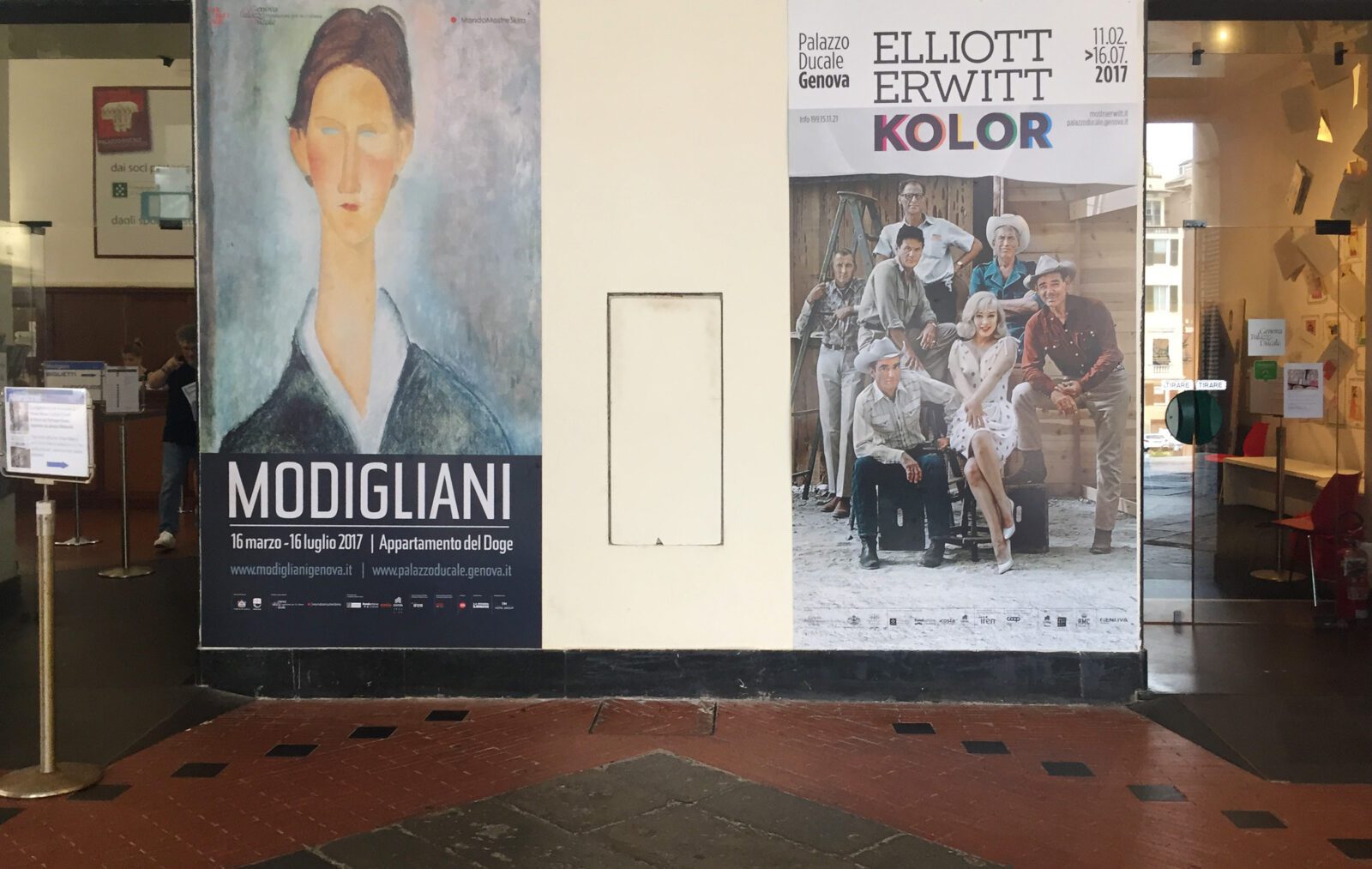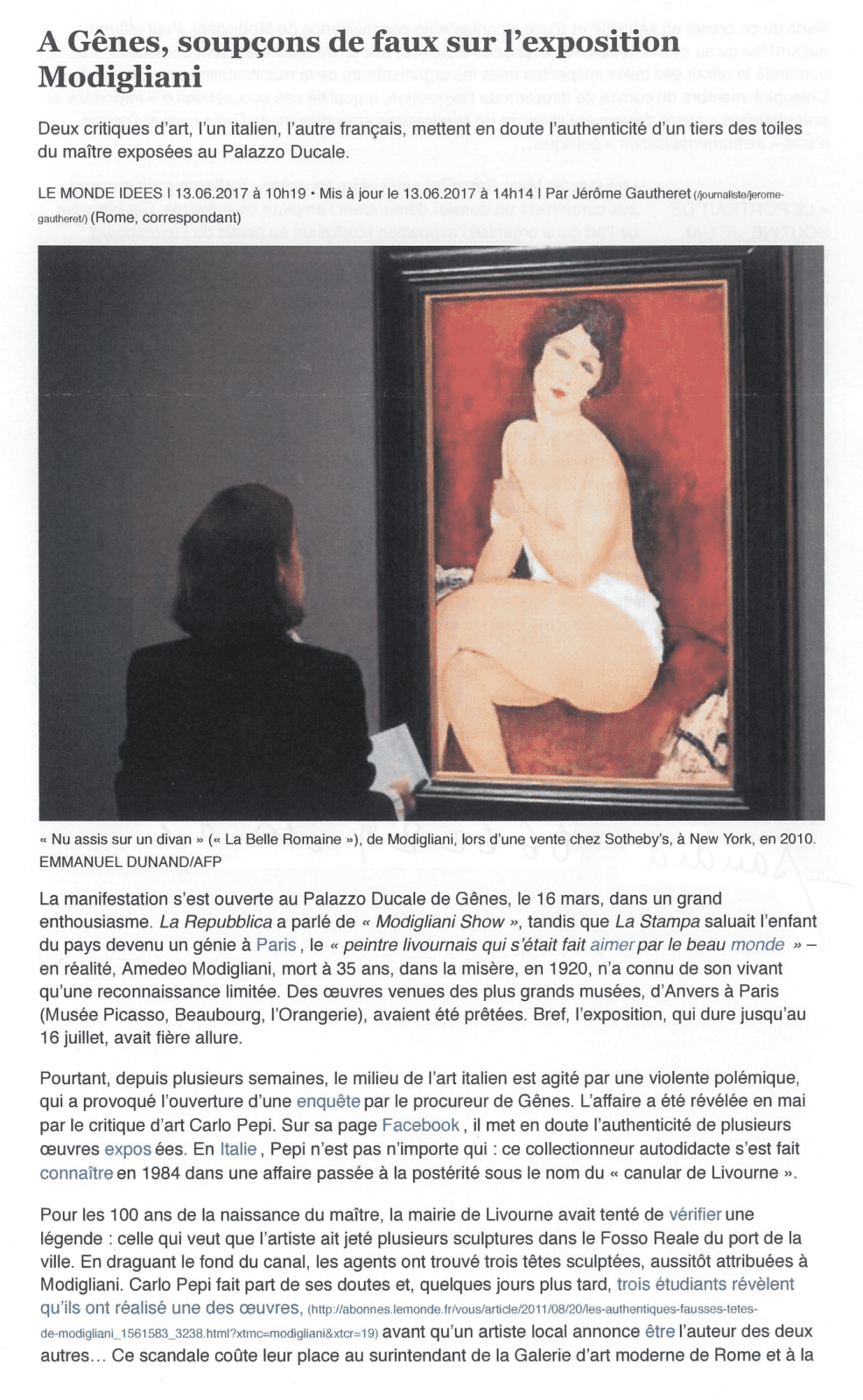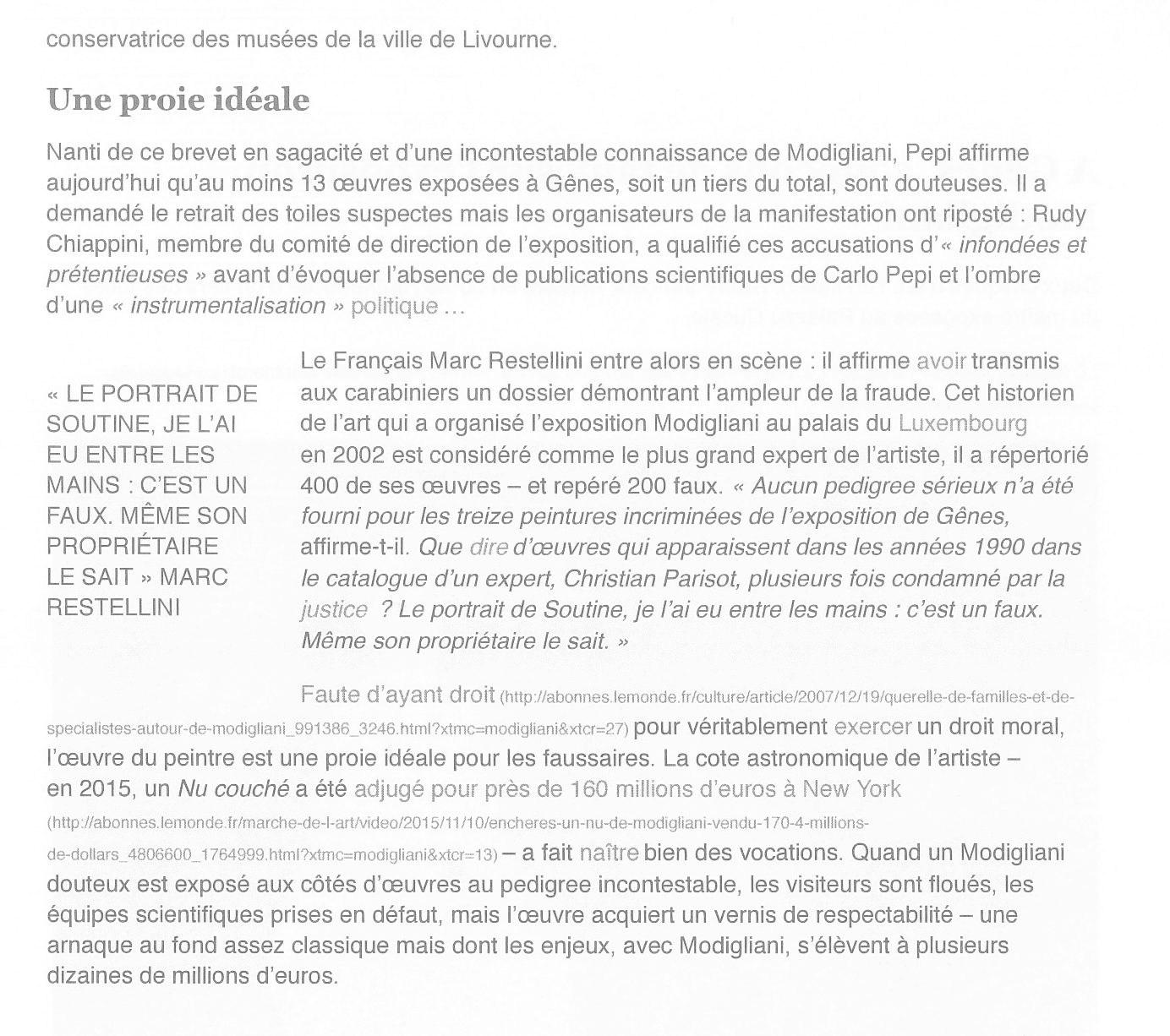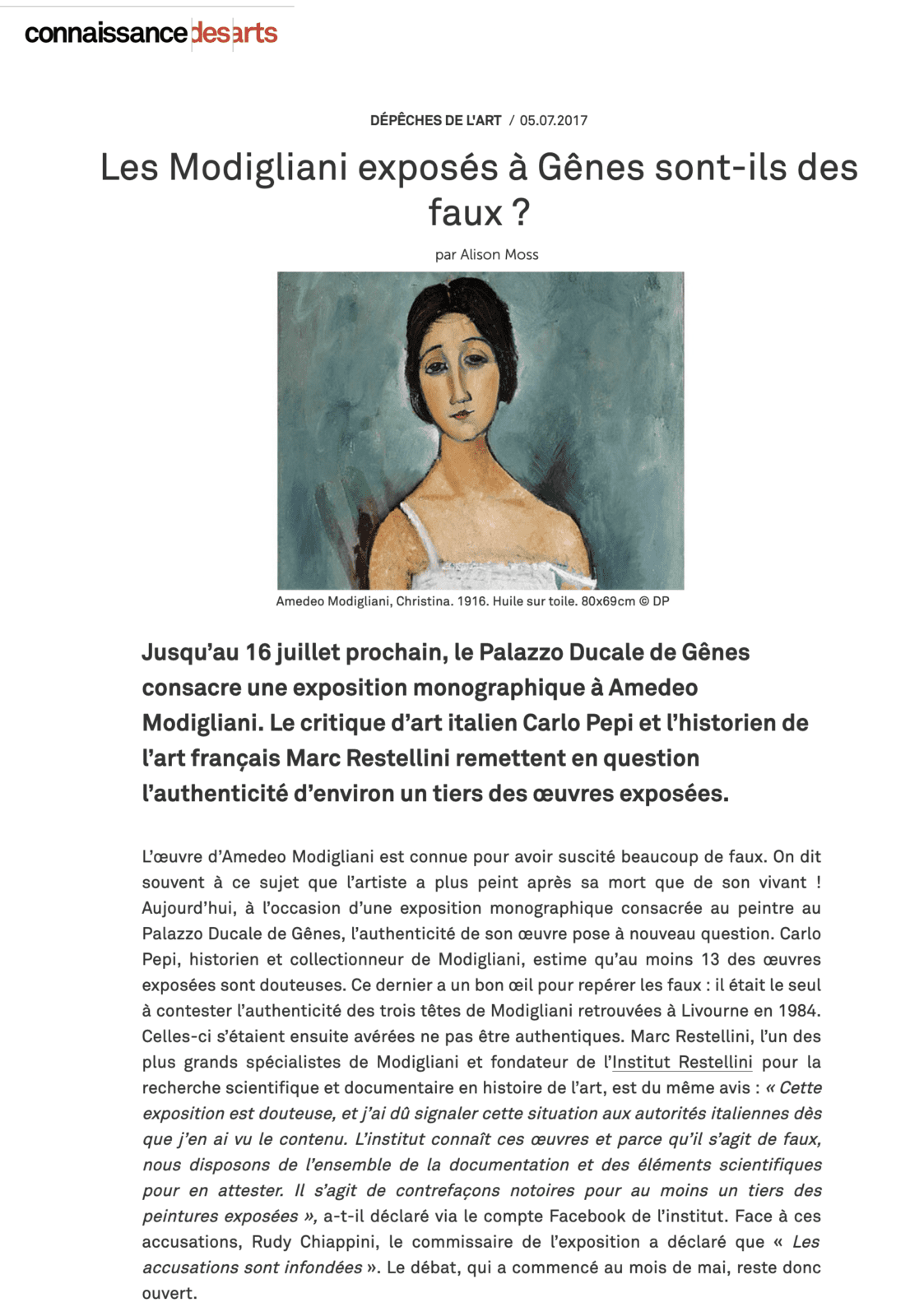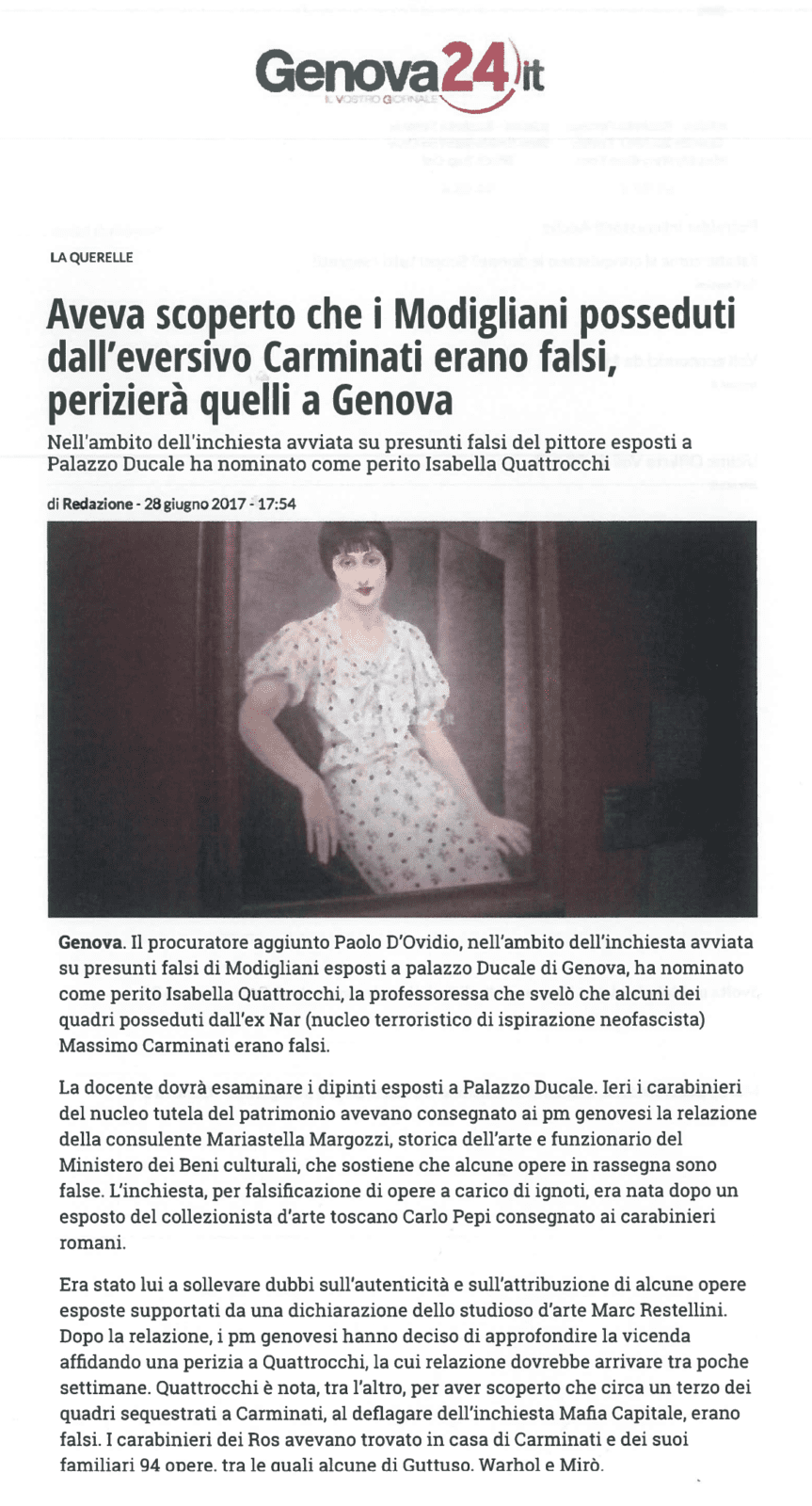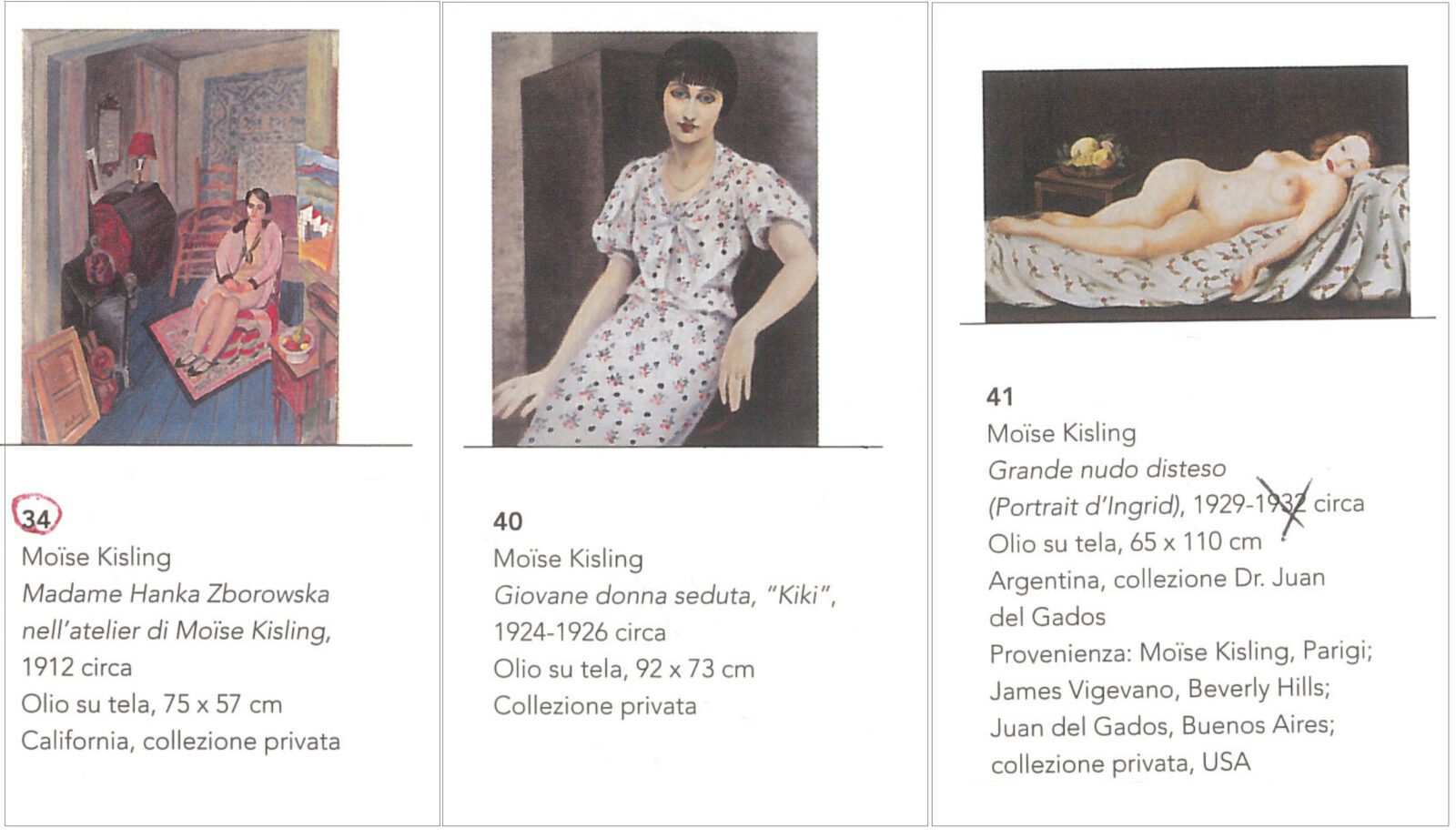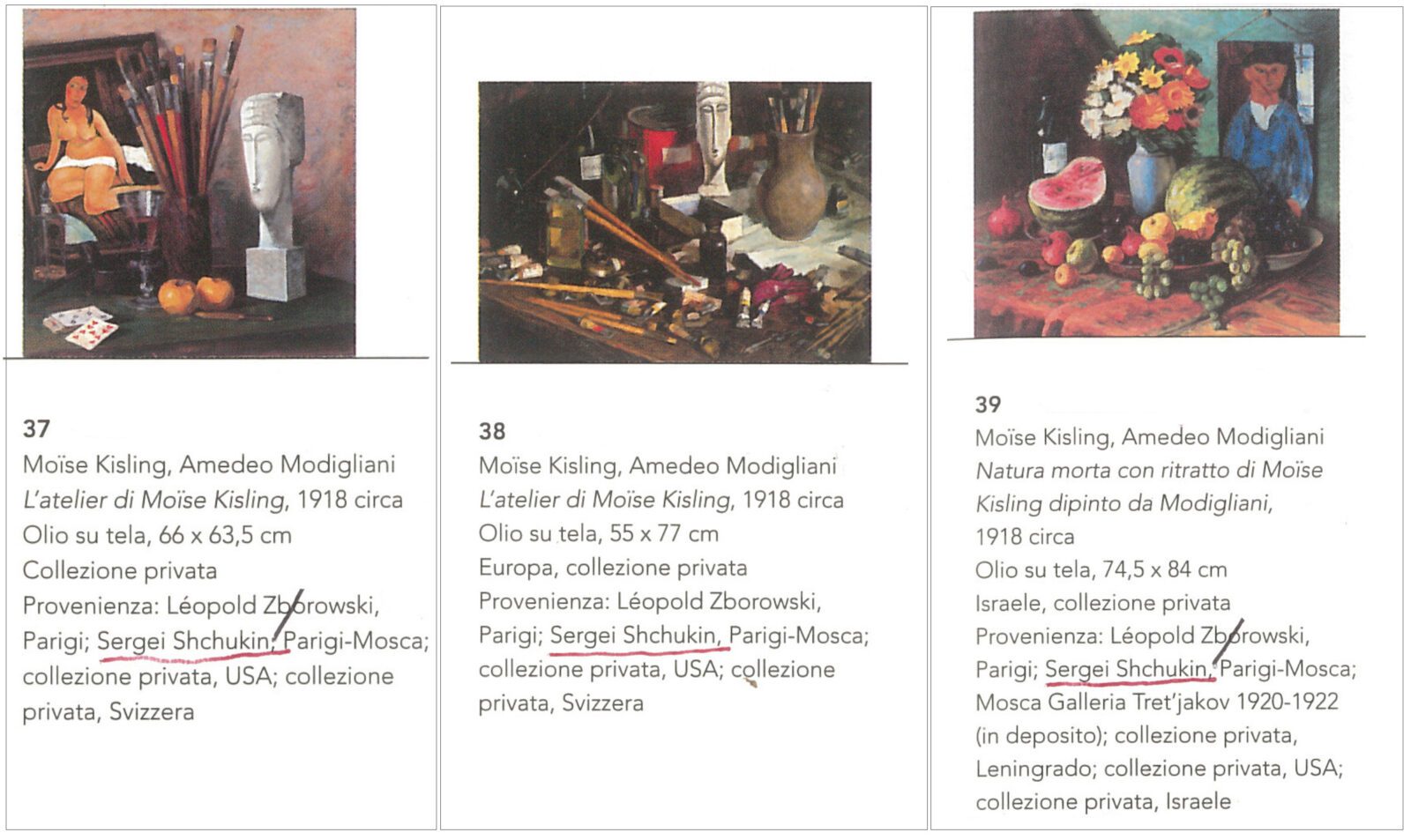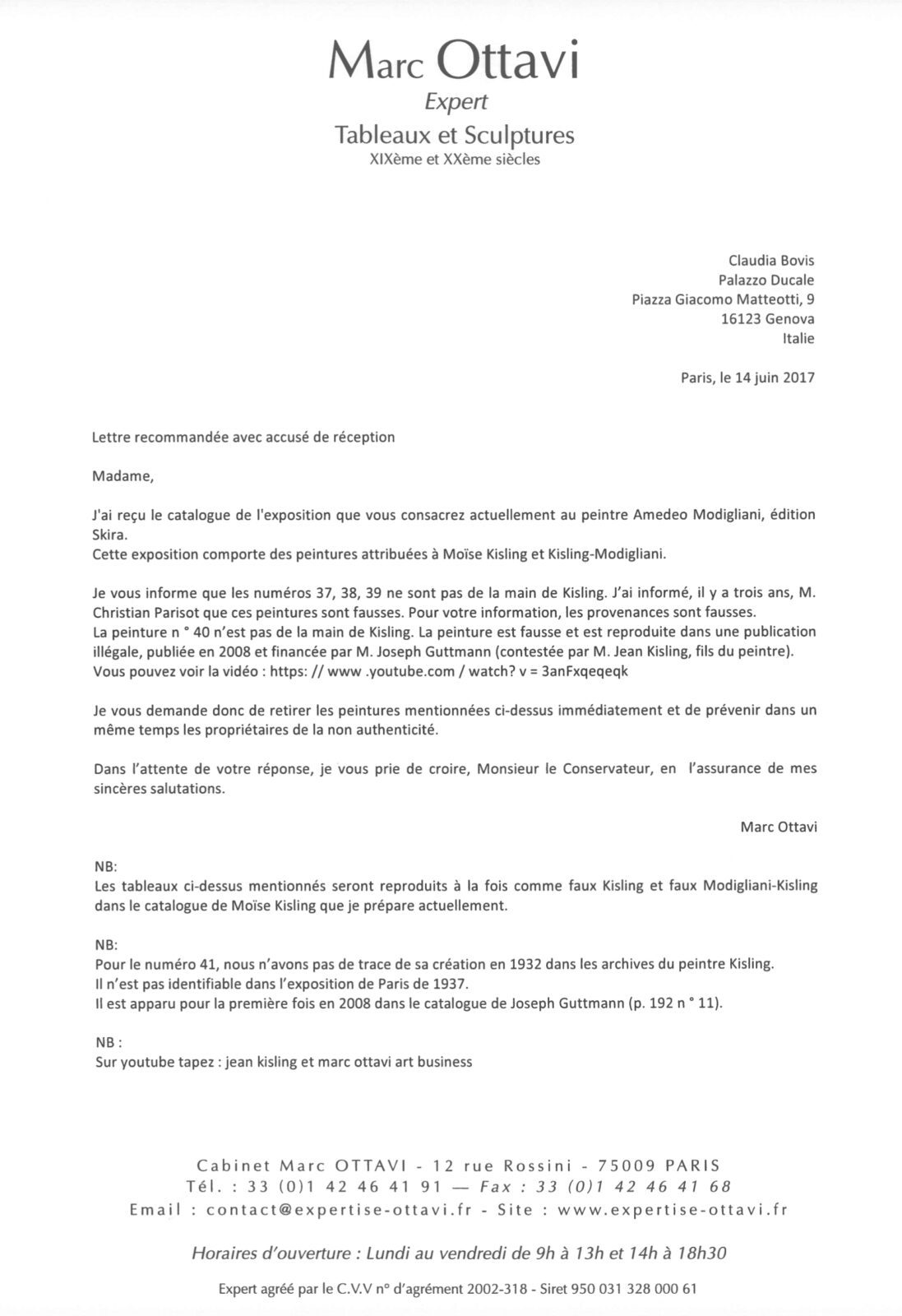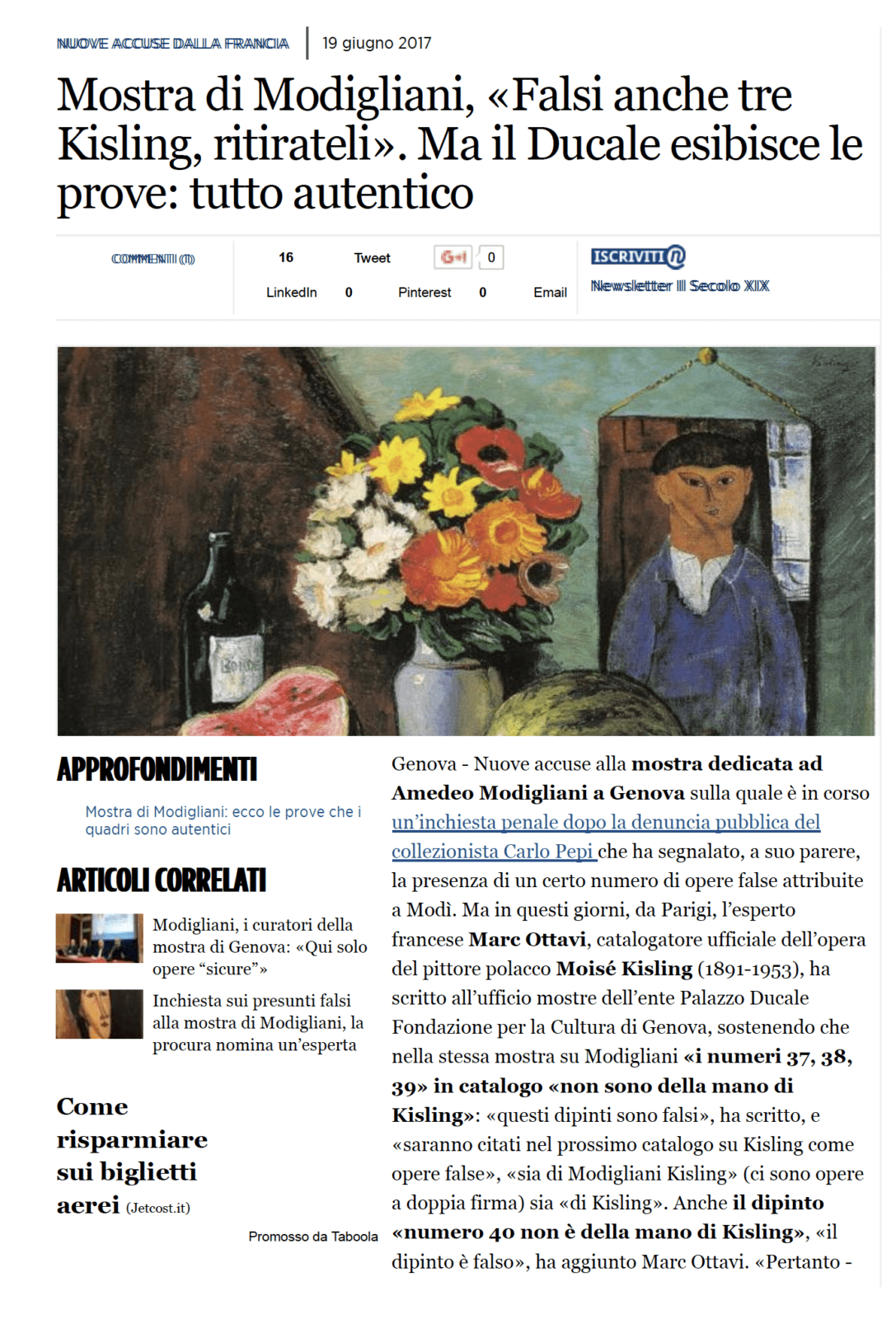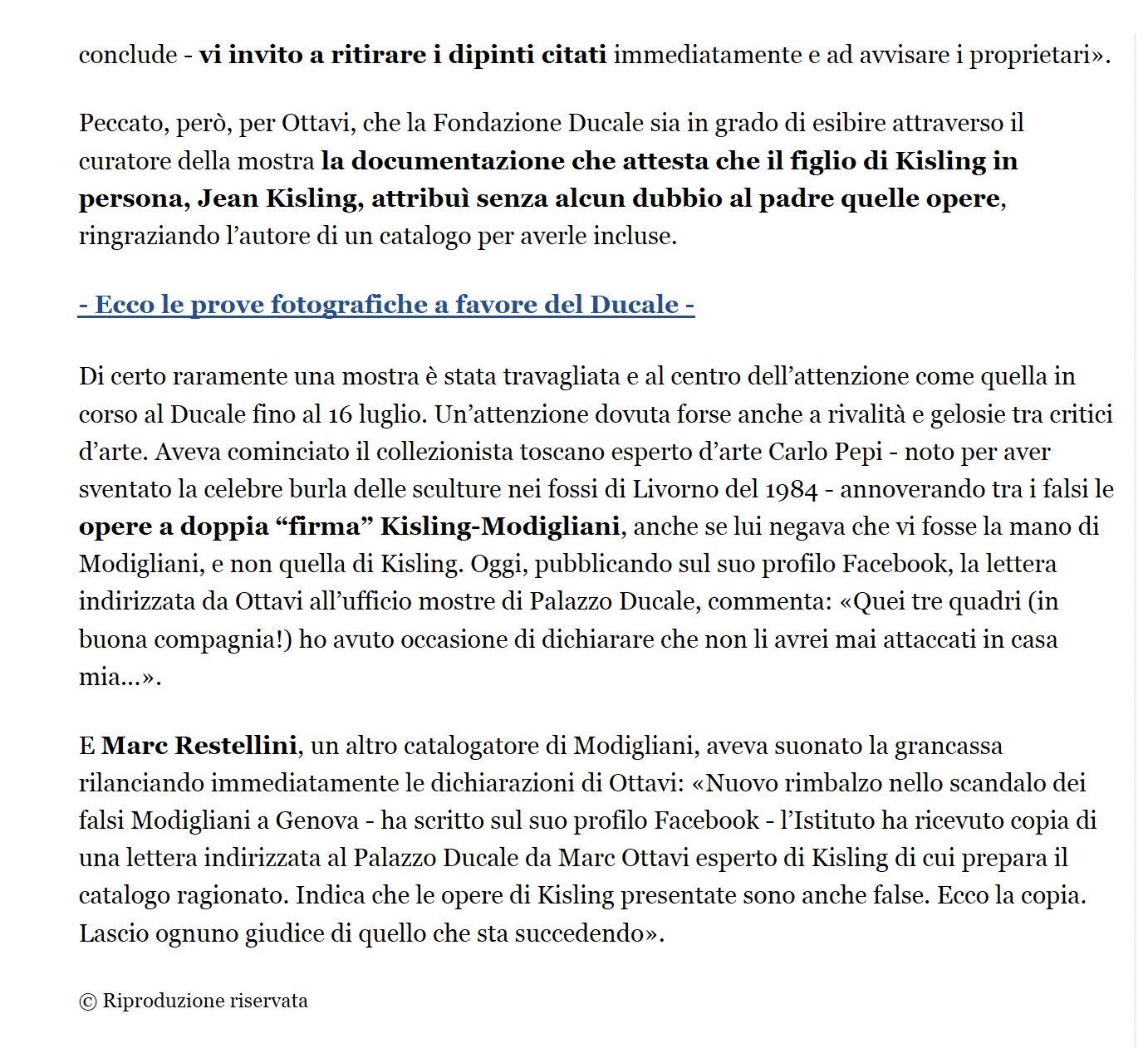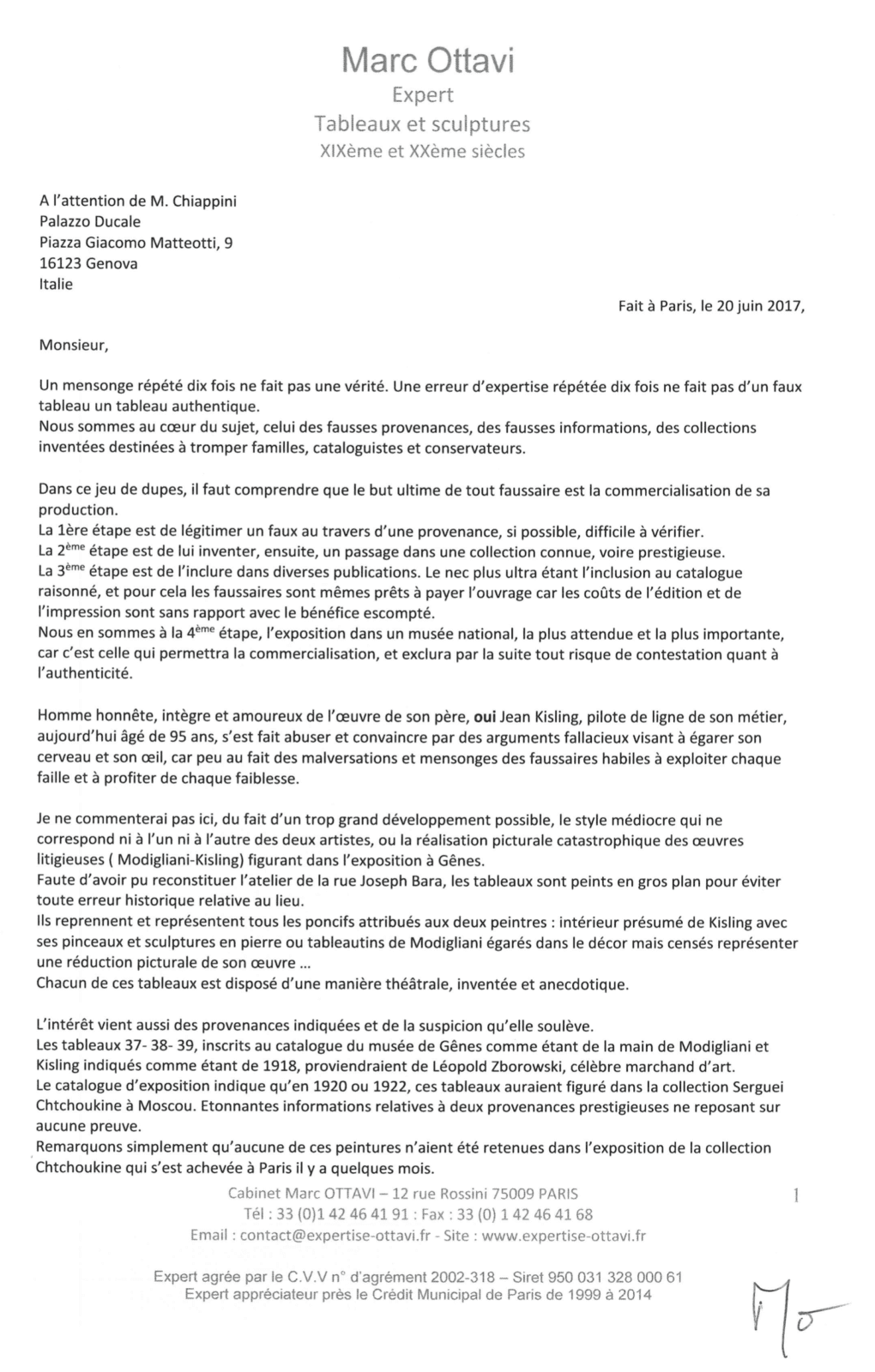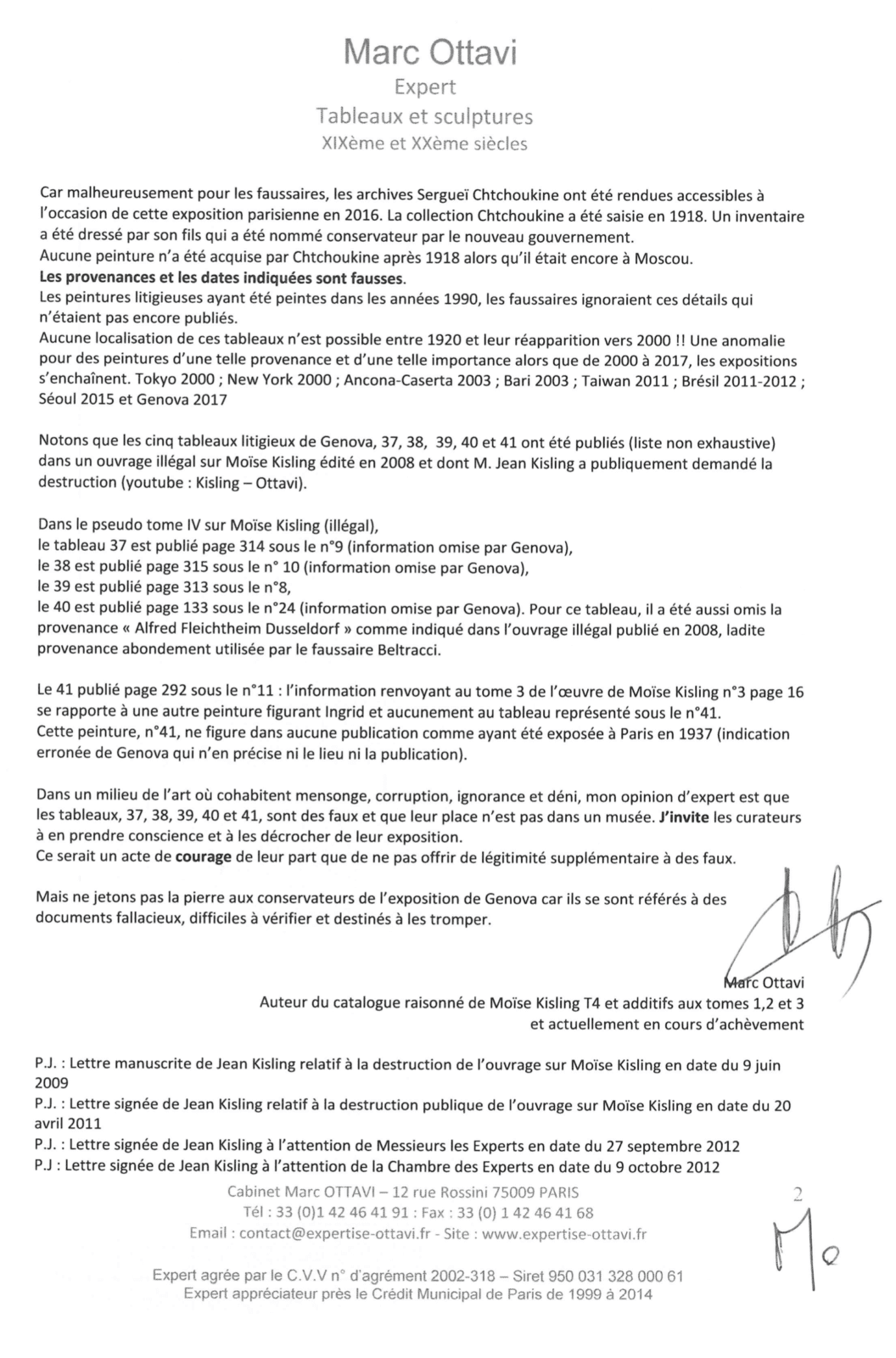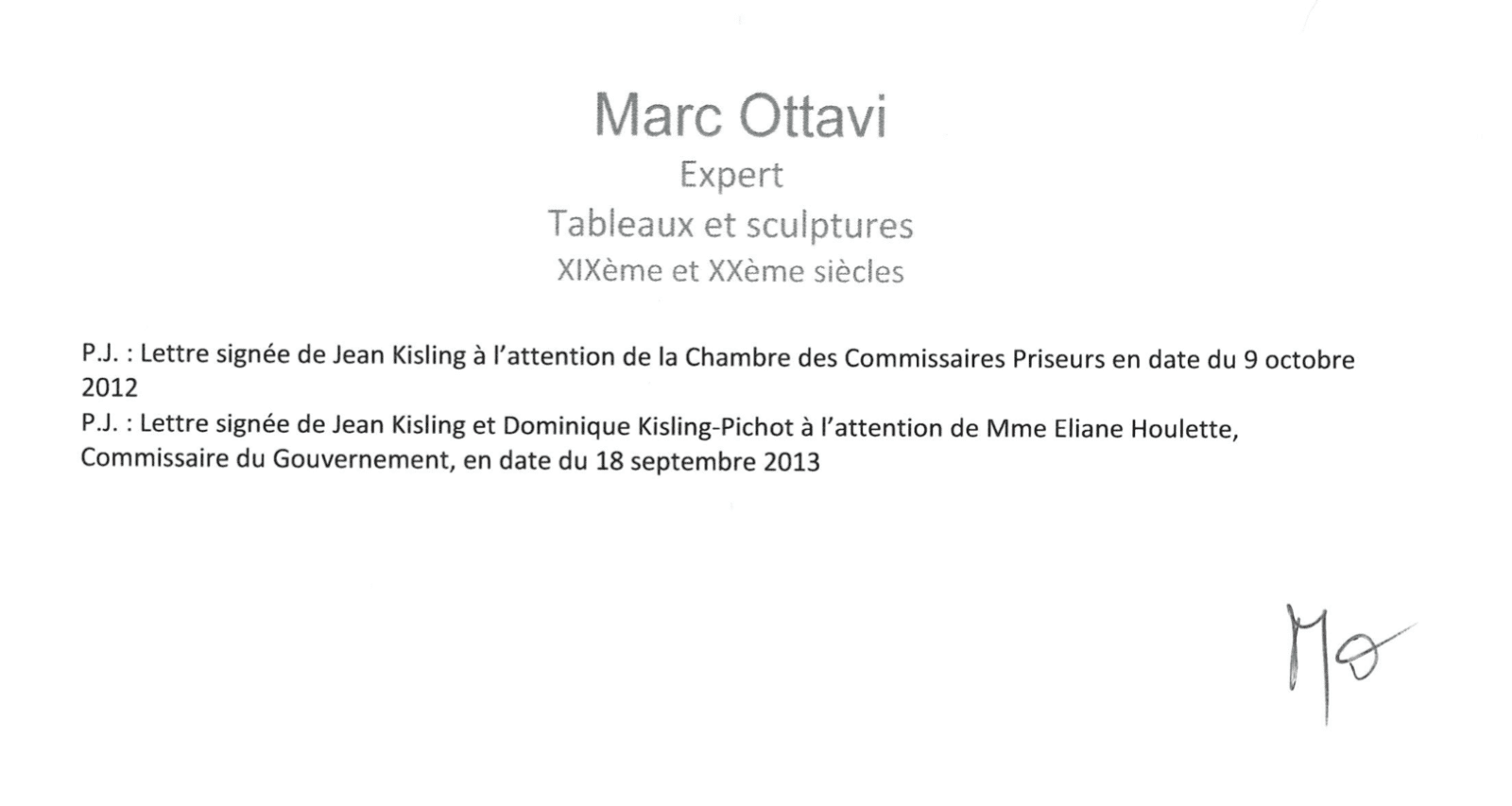Early termination of the « Modigliani » exhibition at the Palazzo Ducale in Genoa in 2017.
Reminder of the facts:
On March 16, 2017, a » Modigliani » exhibition opened at the Palazzo Ducale in Genoa.
54 paintings presumed to be by the artist are presented, plus 3 paintings presumed to be collaborative pieces by painters Amedeo Modigliani and Moïse Kisling, plus 3 paintings bearing a » Kisling » signature.
In the foreword of the catalog, the curators of the exhibition Rudy Chiappini, Dominique Vieville and Stefano Zuffi thank Joseph and Johanna Guttmann for their active collaboration in the realization of this prestigious exhibition.
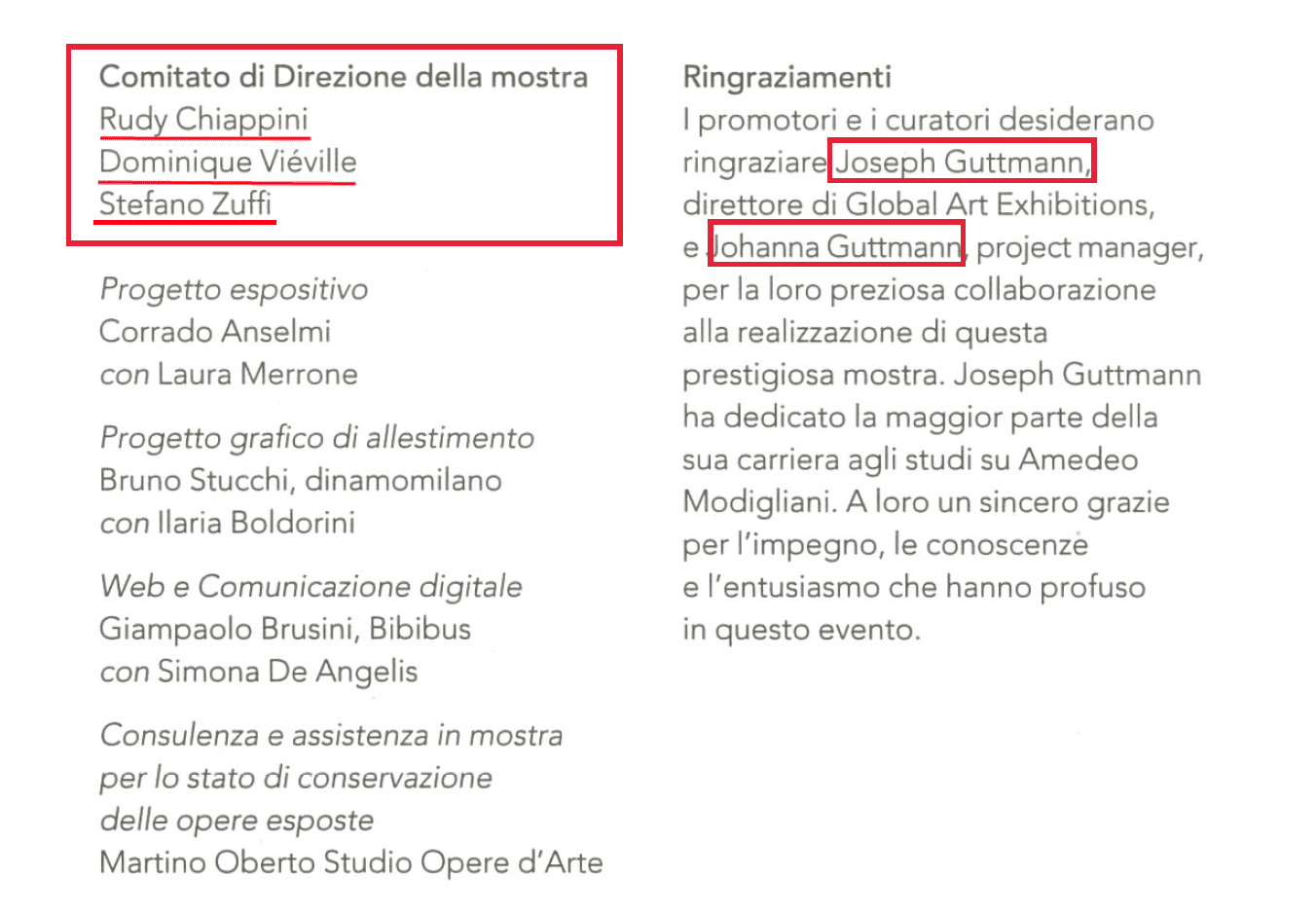
Page de garde du catalogue d’exposition « Modigliani »
Some Italian experts raised doubts about the authenticity of several paintings that the curators presented as being works by Modigliani:
Genoa, suspicions of forgery at the Modigliani exhibition
Two art critics, one Italian, the other French, are questioning the authenticity of a third of the master’s paintings, exhibited at the Palazzo Ducale.
LE MONDE IDÉES 13.06.2017 at 10:19 am. Updated 13.06.2017 at 14:14 By Jérôme Gautheret (Rome, correspondent)
The event opened at the Palazzo Ducale in Genoa on March 16 with great enthusiasm. La Repubblica spoke of the « Modigliani Show », while La Stampa saluted the local boy who became a genius in Paris, the « Livornese painter who was loved by the upper class » – in reality, Amedeo Modigliani, who died in poverty at 35 in 1920, only received limited recognition during his lifetime. Paintings had been lent by the greatest museums, from Antwerp to Paris (Musée Picasso, Beaubourg, l’Orangerie). In short, the exhibition, which was scheduled to last until July 16, looked promising.
However, for several weeks, the Italian art world has been agitated by a violent controversy, which led to the opening of an investigation by the Genoa prosecutor. The case was revealed in May by the art critic Carlo Pepi. On his Facebook page, he questioned the authenticity of several of the pieces on display. In Italy, Pepi is not just anyone: this self-taught collector became known in 1984 in a case that became known as the « Livorno hoax ».
For the 100th anniversary of the Master’s birth, the town hall of Livorno had tried to verify a legend: that the artist had thrown several sculptures into the Fosso Reale in the city’s harbour. While dredging the bottom of the canal, the officers found three sculpted heads, that were immediately attributed to Modigliani. Carlo Pepi expressed his doubts and, a few days later, three students revealed that they had made one of the pieces (http://abonnes.lemonde.fr/vous/article/2011/08/20/les-authentiques-fausses-tetesde-modigliani_1561583_3238.html?xtmc-modigliani&xtcr-19) before a local artist announced that he was the maker of the other two… This scandal costs the superintendent of the Gallery of Modern Art in Rome and the curator of the Livorno museums their jobs.
An ideal prey
Armed with this proof of sagacity and an undeniable knowledge of Modigliani, Pepi asserts today that at least 13 works exhibited in Genoa, a third of the total, are questionable. He’s asked for the withdrawal of the suspicious paintings, but the organizers of the event have retaliated: Rudy Chiappini, a member of the steering committee of the exhibition, called these accusations « unfounded and pretentious » before mentioning the lack of scientific publications by Carlo Pepi and the shadow of a political « instrumentalization » …
« THE PORTRAIT OF SOUTINE, I HAD IT IN MY HANDS. IT IS A FAKE. EVEN THE OWNER KNOWS IT » MARC RESTELLINI
Frenchman Marc Restellini then enters the scene: he claims to have transmitted to the carabinieri a file showing the extent of the fraud. This art historian who organized the Modigliani exhibition at the Palais du Luxembourg in 2002 is considered the greatest expert on the artist : he has listed 400 of his works – and spotted 200 fakes. « No serious pedigree has been provided for the thirteen incriminated paintings in the Genoa exhibition, » he says. What about the pieces that appeared in the 1990s in the catalog of an expert, Christian Parisot, several times convicted by the courts? The portrait of Soutine, I had it in my hands, it is a fake. Even the owner knows it. »
In the absence of a rightful owner (http://abonnes.lemonde.fr/culture/article/2007/12/19/querelle-de-familles-et-de specialistes-autour-de-modigliani_991386_3246.html?xtmc-modigliani&xtcr=27) to truly exercise a moral right, the painter’s work is an ideal prey for forgers. The artist’s astronomical price tag – in 2015, a Reclining Nude was auctioned for nearly 160 million euros in New York
(http://abonnes.lemonde.fr/marche-de-l-art/video/2015/11/10/encheres-un-nu-de-modigliani-vendu-170-4-millions de-dollars_4806600_1764999.html?xtmc-modigliani&xtcr=13) – has given rise to many vocations. When a questionable Modigliani is exhibited alongside works of unquestionable pedigree, visitors are cheated, the scientific teams are taken for a ride, but the piece acquires a veneer of respectability – a fairly classic scam, but one whose stakes, with Modigliani, amount to several tens of millions of euros.
05.07.2017 by Alison Moss
Are the Modiglianis being exhibited in Genoa fakes?
Amedeo Modigliani, Christina. 1916. Oil on canvas. 80x69cm © DP
Until July 16, the Palazzo Ducale in Genoa is dedicating a monographic exhibition to Amedeo Modigliani. The Italian art critic Carlo Pepi has called into question the authenticity of about a third of the pieces on display.
Amedeo Modigliani’s work is known to have generated many forgeries. It is often said that the artist painted more after his death than during his lifetime! Today, at the occasion of a monographic exhibition dedicated to the painter at the Palazzo Ducale in Genoa, the authenticity of his work is once again being questioned. Carlo Pepi, historian and collector of Modigliani, believes that at least 13 of the pieces exhibited are questionable. He has a good eye for forgeries: he was the only one to contest the authenticity of the three heads by Modigliani found in Livorno in 1984. These were later found to be inauthentic. Today, however, these statements remain hypotheses. « The accusations [of Carlo Pepi] are unfounded, » said Rudy Chiappini, the curator of the exhibition. The argument, which began in May, remains open.
She had discovered that the paintings made by the eversive Carminati were fakes, she will examine the works in Genoa.
Genova24.lt, July 28, 2017, 17:54
Genoa. Deputy Prosecutor Paolo d’Ovidio, as part of the investigation into the forgeries of
Modigliani exhibited at Palazzo Ducale, has appointed Isabella Quattrocchi, the professor who revealed the falsity of some paintings owned by the ex Nar (terrorist nucleus of neo-fascist inspiration) Massimo Carminati.
Isabella Quattrocchi will examine the paintings exhibited at the Palazzo Ducale.
Yesterday, the Office for heritage protection submitted to the Genoan court the report of consultant Mariastella Margozzi, art historian and civil servant of the Ministry of Cultural Heritage, which claims that some of the pieces on display are forgeries.
The investigation into the falsification of art pieces by unknown persons began after art collector Carlo Pepi reported the matter to the police in Rome.
Carlo Pepi raised doubts (supported by a statement by art expert Marc Restellini) about the authenticity and attribution of certain pieces on display.
After this report, the Genoese magistrates decided to investigate the matter further, entrusting the examination of the pieces to Ms. Quattrocchi, whose report should arrive in a few weeks. Ms. Quattrocchi is known, among other things, for having discovered that about a third of the paintings confiscated from Carminati, during the explosion of the Mafia Capitale investigation, were forgeries. The Gendarmerie of the Ros (Special Operational Grouping) had found 94 works of art at Carminati’s home and those of his relatives, including some Guttuso, Warhol and Mirò.
Text by Marc Ottavi :
In June 2017, after visiting the exhibition at the Palazzo Ducale, I sent a simple letter to the people in charge of the exhibition, Ms. Claudia Bovis and Matteo Fochessati, informing them that the 3 paintings bearing a « Kisling » signature (#34, #40 and #41 in the catalog) were fakes.
Moreover, 3 paintings presented as collaborative works painted collaboratively by Modigliani and Kisling (n° 37, 38 and 39 of the catalog), although signed with both names, are also fakes.
Claudia Bovis
Palazzo Ducale
Piazza Giacomo Matteotti, 9
16123 Genoa
Italy
Paris, June 14, 2017
Registered letter with confirmation of delivery
Dear Madam,
I have received the catalog of the exhibition that you are currently dedicating to the painter Amedeo Modigliani, Skira edition. This exhibition includes paintings attributed to Moïse Kisling and Kisling-Modigliani.
I would like to inform you that numbers 37, 38, 39 are not by Kisling. I informed Mr. Christian Parisot three years ago that these paintings were fakes. For your information, the provenances are false. Painting n°40 is not by Kisling. The painting is fake and is reproduced in an illegal publication, published in 2008 and financed by Mr. Joseph Guttmann (contested by Mr. Jean Kisling, son of the painter). Video available here: https://www.youtube.com/watch? v= 3anFxqeqeqk.
I therefore ask you to remove the above-mentioned paintings immediately and at the same time, to inform the owners of their non-authenticity.
In the expectation of your answer, please believe, Mr. Curator, in the assurance of my warmest regards.
Marc Ottavi
NB:
The above-mentioned paintings will be reproduced as both fake Kisling and fake Modigliani-Kisling in the Moïse Kisling catalog that I am currently compiling.
NB:
For number 41, we have no record of its creation in 1932 in the archives of the painter Kisling. It is not identifiable in the Paris exhibition of 1937.
It appeared for the first time in 2008 in Joseph Guttmann’s catalog (p. 192 n°11).
NB:
On youtube type: jean kisling and marc ottavi art business
On June 19, I was surprised to discover that Mr. Rudy Chiappini, curator, had answered me in an article in « Il secolo XIX » with the title « Peccato per Ottavi », we have the certificates of Jean Kisling.
On June 20, 2017, I replied to Mr. Chiappini that a lie repeated 100 times does not make a truth, and that a fake painting exposed 100 times does not make it authentic:
To the attention of Mr. Chiappini
Palazzo Ducale
Piazza Giacomo Matteotti, 9
16123 Genoa
Italy
Paris, June 20, 2017,
Dear Sir,
A lie repeated ten times does not make a truth. An authentication error repeated ten times does not make a fake painting authentic.
We are at the heart of the matter, that of false provenances, false information, made-up collections intended to deceive families, cataloguers and curators.
In this game of fools, we must understand that the ultimate goal of any forger is the marketing of their production.
The first step is to legitimize a fake through a provenance, if possible, difficult to verify.
The 2nd step is to invent a transit through a renowned or even prestigious collection.
The 3rd step is to include it in various publications. The absolute top step is to include it in a catalogue raisonné, and for this, forgers are even ready to pay for the work, because the costs of editing and printing are insignificant compared to the expected profit.
We are at the fourth stage : the exhibition in a national museum, the most awaited and the most important, because it is the one that will enable the commercialization, and will exclude thereafter any risk of contestation about the authenticity of the piece.
Jean Kisling, an airline pilot by profession, is an honest man. He has integrity and he is in love with his father’s work. At 95 years old, he was deceived and convinced by fallacious arguments aiming at misleading his brain and his eye, because he was not aware of the forgers’ malpractices, lies and talent for taking advantage and exploiting every flaw and every weakness.
I will not comment any further here, to avoid too much development, on the mediocre style that does not match either of the two artists, or on the catastrophic pictorial realization of the litigious works (Modigliani-Kisling) appearing in the Genoa exhibition.
Since it was not possible to reconstruct the Joseph Bara Street studio, the paintings are painted in close-ups in order to avoid any historical error concerning the place.
They take up and represent all the clichés attributed to the two painters: Kisling’s presumed interior with his paint brushes and stone sculptures, or Modigliani’s tablets lost in the decor, but supposed to represent a pictorial reduction of his work…
Each of these paintings is arranged in a theatrical, made-up and anecdotal fashion.
The interest also comes from the provenances indicated and the suspicion that they raise.
Paintings 37- 38- 39, listed in the Genoa Museum catalog as being by Modigliani and Kisling, marked as being from 1918, are said to have come from Leopold Zborowski, a famous art dealer.
The exhibition catalog indicates that in 1920 or 1922, these paintings would have been in the Sergei Shchukin collection in Moscow. This is an astounding piece of information about two prestigious provenances that are not supported by any evidence.
Let us simply note that none of these paintings were included in the exhibition of the Shchukin collection which ended in Paris a few months ago.
Because unfortunately for the forgers, the Sergei Shchukin archive was made available at this Paris exhibition in 2016. The Shchukin collection was confiscated in 1918. An inventory was established by his son who was appointed curator by the new government.
No paintings were acquired by Shchukin after 1918 while he was still in Moscow.
The provenances and dates given are false.
Since the disputed paintings were painted in the 1990s, the forgers were unaware of these details, which had not yet been published.
The whereabouts of these paintings cannot be traced between 1920 and their reappearance around 2000! This is an anomaly for paintings of such provenance and importance, while from 2000 to 2017, exhibitions follow one another. Tokyo 2000; New York 2000; Ancona-Caserta 2003; Bari 2003; Taiwan 2011; Brazil 2011-2012; Seoul 2015 and Genoa 2017
Please note, that the five contentious Genoa paintings, 37, 38, 39, 40 and 41 were published (non-exhaustive list) in an illegal book about Moïse Kisling, published in 2008 and for which Mr. Jean Kisling has publicly requested destruction (youtube: Kisling – Ottavi).
In the pseudo volume IV about Moïse Kisling (illegal),
painting 37 is published on page 314 under n°9 (information omitted by Genoa),
number 38 is published on page 315 under number 10 (information omitted by Genoa),
number 39 is published on page 313 under number 8,
number 40 is published on page 133 under number 24 (information omitted by Genoa). For this painting, the provenance « Alfred Fleichtheim Dusseldorf » was also omitted, as indicated in the illegal book published in 2008. This provenance has been abundantly used by forger Beltracci.
Number 41, published on page 292 under number 11: the information referring to volume 3 of the work of Moïse Kisling, number 3 on page 16, refers to another painting depicting Ingrid and not to the painting represented under number 41.
This painting, no. 41, does not appear in any publication as having been exhibited in Paris in 1937 (Genoa’s erroneous indication of where it was exhibited or published).
In an art world where lies, corruption, ignorance and denial coexist, my expert opinion is that paintings 37, 38, 39, 40 and 41 are fakes and do not belong in a museum. I invite the curators to realize this and to remove them from their exhibition.
It would be an act of courage on their part not to offer additional legitimacy to fakes.
But let us not blame the curators of the Genoa exhibition because they referred to false documents, difficult to verify and intended to deceive them.
Marc Ottavi
Author of the catalog raisonné of Moïse Kisling Volume 4 and additions to volumes 1, 2 and 3 and currently being completed
- attached document: Handwritten letter from Jean Kisling regarding the destruction of the book about Moïse Kisling dated June 9, 2009
- attached document: Letter signed by Jean Kisling concerning the public destruction of the book about Moïse Kisling dated April 20, 2011
- attached document: Letter signed by Jean Kisling to the attention of the Experts dated September 27, 2012
- attached document: Letter signed by Jean Kisling to the attention of the Chamber of Experts dated October 9, 2012
- attached document: Letter signed by Jean Kisling to the attention of the Chambre des Commissaires Priseurs dated October 9, 2012
- attached document: Letter signed by Jean Kisling and Dominique Kisling-Pichot to the attention of Mrs. Eliane Houlette, Government Commissioner, dated September 18, 2013
On July 5, 2017, I published a press release inviting people to check out of the exhibition, whose interest lies in the comparison between real and fake, a chance rarely offered to visitors:
Press release of July 5, 2017
Fake paintings by Modigliani and Kisling in Genoa
A magnificent « Modigliani » exhibition is taking place in Genoa where for once in a museum the public will be able to admire side by side real paintings by Modigliani (some of them lent by French museums) and false pieces wrongly attributed to the master of Livorno.
This rare opportunity to distinguish the real from the copy, is to be seized before the official closing of the exhibition, on July 16, unless the judicial expert, Mrs. Isabella Quattrocchi, appointed for the investigation by the Deputy Prosecutor of Genoa, Mr. Paolo D’Ovidio, decides on an early closing.
This is not at all desirable because the amateur as well as the professional will be able to educate their eye and carry out a screening that was until now reserved to the experts officiating in the auction houses.
Once there, forget the sumptuous setting of the Palazzo Ducale and ignore the overwhelming spotlights, which tend to make the paintings uniform, under a deluge of warm light. Imagine the paintings outside, in daylight, then observe and compare the differences in treatment and rendering between each piece, knowing that both Modigliani and Kisling always breathed life into their models or compositions.
Amongst authentic masterpieces, you will be able to admire thirteen fake pieces by Modigliani (according to Marc Restellini), then three fake Kisling and (rare) three paintings of an imaginary four-handed collaboration between Modigliani and Kisling, for which the forger had to use his imagination and invent an intermediate style between the two artists.
In the latter case, however, no luck for this fantasy, since the provenance, the Sergei Shchukin collection, indicated in the catalog of the Genoa exhibition, turns out to be just as fake as the paintings. This is further corroborated by the extraordinary retrospective, on this Russian collector, organized until March 2017 by the Louis Vuitton Foundation, where none of these three paintings took place, and which do not appearin in the inventory established at the time when they were seized by the Bolsheviks.
Since the website of Palazzo Ducale does not have any photographs of the paintings presented in the exhibition, you will have to travel to Genoa, where you can visit the beautiful historic center.
Marc OTTAVI
On July 14, 2017, following the accumulation of incriminating evidence, the carabinieri proceeded to the early shutdown of the « Modigliani » exhibition in Genoa, by court order.
Press release, July 20, 2017
Early court ordered closing of the Modigliani exhibition in Genoa
The investigation into the Modigliani-Kisling forgeries and Kisling forgeries exhibited at the Palazzo Ducale in Genoa, undertaken under the authority of Deputy Prosecutor Paolo d’Ovidio and expert Isabella Quattrocchi, should shed light on the new methods of the super forgers to introduce forgeries and copies into the Art Market.
A single goal, the marketing of their production and its resale with impunity. Forgers use all means at their disposal: fabricated provenances, made-up collections, ignorance of the beneficiaries and curators, even corruption, production of catalogs, museum exhibitions on all continents…
In view of the expected profits, no expense is spared to take advantage of the weaknesses of the Art Market and the lack of coherence of national and international laws. Obviously, this deception is only possible because of the lack of interest shown by our institutions towards one of the great movements of the beginning of the 20th century, the Ecole de Paris, about which no large-scale event has been organized for more than twenty years. This failure obviously leads to a loss of knowledge and reference points, from which the public and the one hundred thousand visitors to the exhibition at the Palazzo Ducale have suffered.
Only three voices expressed their indignation in order for the truth to come out, including those of Marc Restellini and Carlo Pepi. It is time to change the laws and to make the experts a central element of the authentication.
Marc OTTAVI
In order to legitimize the authenticity of the disputed pieces, one of the major arguments of the curators was to rely on previous exhibitions, where these fake paintings had been shown.
However, the curators carefully omitted the fact that these precedents were under the control of the same commissioning parties, and sometimes even the same curators, such as, for example, Rudy Chiappini, curator of the 2015 exhibition in Seoul.
After the early shutdown of the » Modigliani » exhibition,
Out of 54 paintings bearing the » Modigliani » signature, 15 were confiscated.
Out of 3 paintings bearing the « Modigliani-Kisling » signatures, 3 were confiscated.
Out of 3 paintings bearing the « Kisling » signature, 3 were confiscated.
Marc OTTAVI

